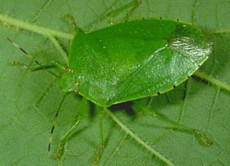Green Stinkbug in Soybeans
Green Stinkbug
Description

Green Stinkbug
University of Kentucky Dept. Entomology
The adult green stinkbug is shaped like a shield and is about one-half inch long. Immature stages, or nymphs, look like adults but are smaller and do not have wings. Green stink bug nymphs vary in color but have some red markings.
Damage
The green stink bug feeds on plant sap rather than chewing on vegetation. A pod feeder, the green stink bug feeds on soybean pods with its piercing, sucking mouthparts. This causes discolored, shriveled beans and reduces the yield and quality of the beans.
IPM Techniques and Scouting
Stink bugs usually appear first in field margins and border rows.
- When scouting a field for stink bugs, first check the two field borders closest to woody vegetation.
- Using a sweep net, take 50 sweeps along each border. Note the number of stink bugs collected at each field border. If the samples contain 25 or more stink bugs per 50 sweeps then sample again with a shake cloth.
- The number of sites you need to examine in a field is based on the size of the field.
- Using the shake cloth method, you will need to take five samples along each of the two borders you swept, but NOT in the same rows. Take shake cloth samples at least 20 paces apart. You will need to record the number of insects per four foot sample.
Chemical treatment may be needed if the shake cloth samples average two stink bugs per four foot of row. Large populations of stink bugs often appear in isolated spots within a field or along field borders. A thorough check of a field is necessary to determine the level of infestation.
The technique of trap-cropping can be used to control stink bugs. Stink bugs colonize in soybeans during the plants' reproductive periods of pod set to pod filling; therefore, early-maturing or early-planted beans tend to be more attractive to stink bugs. The population of egg laying adult females and nymphs would be highest in the early-maturing or early-planted beans, thus allowing a producer to only treat this area with an insecticide. Timing, however, is critical to the control of the stink bugs. A chemical control must be applied before the nymphs develop wings and leave the area of beans serving as a trap-crop.
Green Stinkbug Activity

Please note: These dates are approximations only. This calendar was constructed using data from Kentucky, USA. These dates may not apply in your area. You may wish to contact your county extension agent or agricultural consultant for information tailored to your locality.
References and Additional Information
- IPM -3 Kentucky IPM Manual for Soybeans
- Illinois Field Crop Scouting Manual
- Purdue University - Field Crops Pest Management Manual
- Handbook of Soybean Insect Pests by Leon G. Higley and David J. Boethel, Entomological Society of America


